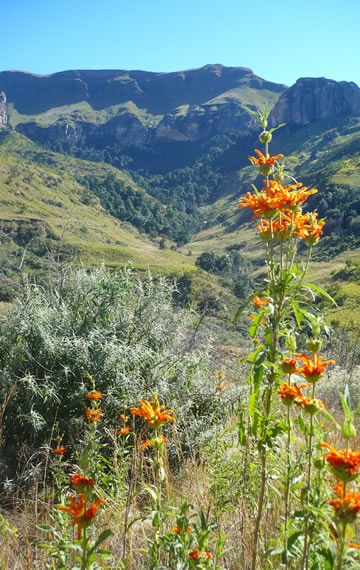GRADE: C+
TIME: 4 hours return.
DISTANCE: 5 km.
TERRAIN: Difficult – steep, slippery and scrambly in places.
The starting point is to follow the directions through the Fern Forest. Upon emerging from the end of the forest take the right hand fork leading up the hill. This path is well defined, and as it ascends it turns right as it approaches a fence. This was installed to prevent rustling. Crawl under it, sticking to the path, which now ascends steeply. Ignore right-hand turns as you approach the sandstone wall. After a few zig-zags the top of the plateau is reached.

A well-earned rest will give sufficient time to enjoy the magnificent views of the Amphitheatre and surrounding mountains. Just before the cliff the path veers to the left, continues in through the trees, and after a short walk reaches the Echo Cave. Be careful crossing the mouth of the cave; the sandstone is very slippery when wet.
The cave wall bears impressive black stripes. These are caused by cyanobacteria growing in seepage water.
Return on the same route. An alternative is to go back to the point where you entered the cave, but take the right hand path descending. There are way-marks on the trees. This path is very steep in places, but the trees provide good hand-holds. A strong walking stick is helpful too. After the first stream look out on your left for two very large yellow-wood trees; these are hundreds of years old.
Yellow-woods have great historical significance. Because they grow straight, and have wood that is easily worked, they were heavily exploited until the twentieth century for furniture and building timber. Because Echo Cave forest is so remote and steep it was never exploited, which is why it has so many yellow-woods. On the greater time-scale yellow-woods contribute to our knowledge of Earth history. Almost identical species are found on all the southern continents, and even as fossils under Antarctic ice. This points to a common ancestry when all these regions were physically joined. This super-continent was Gondwana, and although continental drift has pulled its fragments apart, each still carries some of the original inhabitants.
Close to the path you will see a small, delicate bamboo; it is rare and endemic – found only – in the Berg. Its unique feature is that the leaf veins form a perfect cross-hatch pattern, unlike the parallel veins of other bamboos. Look through a magnifying glass or reversed binoculars. Flowering is rare, only every 40 years or so. Before leaving the forest the path crosses a second stream. Here there are two triangular steel steps anchored into the rock. Use these as the rock is very slippery. Once the path leaves the forest you will come to a kissing gate. Beyond the gate take the left fork downhill. This leads to a steep stepped descent. From here the way to the hotel is obvious.
